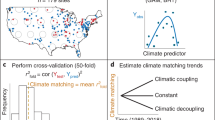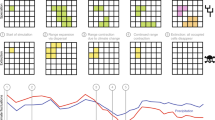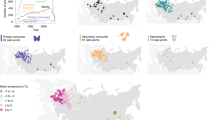Abstract
The hypothesis that animal population dynamics may be synchronized by climate1 is highly relevant in the context of climate change because it suggests that several populations might respond simultaneously to climatic trends if their dynamics are entrained by environmental correlation. The dynamics of many species throughout the Northern Hemisphere are influenced by a single large-scale climate system, the North Atlantic Oscillation (NAO)2,3, which exerts highly correlated regional effects on local weather4. But efforts to attribute synchronous fluctuations of contiguous populations to large-scale climate are confounded by the synchronizing influences of dispersal or trophic interactions5. Here we report that the dynamics of caribou and musk oxen on opposite coasts of Greenland show spatial synchrony among populations of both species that correlates with the NAO index. Our analysis shows that the NAO has an influence in the high degree of cross-species synchrony between pairs of caribou and musk oxen populations separated by a minimum of 1,000 km of inland ice. The vast distances, and complete physical and ecological separation of these species, rule out spatial coupling by dispersal or interaction. These results indicate that animal populations of different species may respond synchronously to global climate change over large regions.
This is a preview of subscription content, access via your institution
Access options
Subscribe to this journal
Receive 51 print issues and online access
$199.00 per year
only $3.90 per issue
Buy this article
- Purchase on Springer Link
- Instant access to full article PDF
Prices may be subject to local taxes which are calculated during checkout



Similar content being viewed by others
References
Moran, P. A. P. The statistical analysis of the Canadian lynx cycle. II. Synchronization and meteorology. Aust. J. Zool. 1, 291–298 (1953)
Ottersen, G. et al. Ecological effects of the North Atlantic Oscillation. Oecologia 128, 1–14 (2001)
Walther, G.-R. et al. Ecological responses to recent climate change. Nature 416, 389–395 (2002)
Marshall, J. et al. North Atlantic climate variability: phenomena, impacts, and mechanisms. Int. J. Climatol. 21, 1863–1898 (2001)
Koenig, W. D. Spatial autocorrelation of ecological phenomena. Trends Ecol. Evol. 14, 22–26 (1999)
Ranta, E., Kaitala, V. & Lindström, J. Spatially autocorrelated disturbances and patterns in population synchrony. Proc. R. Soc. Lond. B 266, 1851–1856 (1999)
Grenfell, B. T. et al. Noise and determinism in synchronized sheep dynamics. Nature 394, 674–677 (1998)
Stenseth, N. C. et al. Common dynamic structure of Canada lynx populations within three climatic regions. Science 285, 1071–1073 (1999)
Schwartz, M. K., Mills, L. S., McKelvey, K. S., Ruggiero, L. F. & Allendorf, F. W. DNA reveals high dispersal synchronizing the population dynamics of Canada lynx. Nature 415, 520–522 (2002)
Hurrell, J. W. Decadal trends in the North Atlantic Oscillation: regional temperatures and precipitation. Science 269, 676–679 (1995)
Forchhammer, M. C., Post, E. & Stenseth, N. C. Breeding phenology and climate. Nature 391, 29–30 (1998)
Forchhammer, M. C., Stenseth, N. C., Post, E. & Langvatn, R. Population dynamics of Norwegian red deer: density-dependence and climatic variation. Proc. R. Soc. Lond. B 265, 341–350 (1998)
Post, E. & Stenseth, N. C. Climatic variability, plant phenology, and northern ungulates. Ecology 80, 1322–1339 (1999)
Milner, J. M., Elston, D. A. & Albon, S. D. Estimating the contributions of population density and climatic fluctuations to interannual variation in survival of Soay sheep. J. Anim. Ecol. 68, 1235–1247 (1999)
Forchhammer, M. C., Clutton-Brock, T. H., Lindström, J. & Albon, S. D. Climate and population density induce long-term cohort variation in a northern ungulate. J. Anim. Ecol. 70, 721–729 (2001)
Haydon, D. T., Stenseth, N. C., Boyce, M. S. & Greenwood, P. E. Phase coupling and synchrony in the spatiotemporal dynamics of muskrat and mink populations across Canada. Proc. Natl Acad. Sci. USA 98, 13149–13154 (2001)
Born, E. W. & Böcher, J. The Ecology of Greenland (Atuakkiorfik, Nuuk, 2001)
Forchhammer, M. C., Post, E., Stenseth, N. C. & Boertmann, D. Long-term responses in arctic ungulate dynamics to variation in climate and trophic processes. Pop. Ecol. 44, 113–120 (2002)
Forchhammer, M. & Boertmann, D. The muskoxen, Ovibos moschatus, in north and northeast Greenland—population trends and the influence of abiotic parameters on population dynamics. Ecography 16, 299–308 (1993)
Klein, D. R. The roles of climate and insularity in establishment and persistence of Rangifer tarandus populations in the high Arctic. Ecol. Bull. 47, 96–104 (1999)
Skogland, T. Comparative Social Organization of Wild Reindeer in Relation to Food, Mates, and Predator Avoidance (Paul Parey, Berlin, 1989)
Post, E. & Klein, D. R. Caribou calf production and seasonal range quality during a population decline. J. Wildl. Manage. 63, 335–345 (1999)
Hedges, L. V., Gurevitch, J. & Curtis, P. The meta-analysis of response ratios in experimental ecology. Ecology 80, 1150–1156 (1999)
Blasius, B. & Stone, L. Ecology—nonlinearity and the Moran effect. Nature 406, 846–847 (2000)
Meldgaard, M. The Greenland caribou—zoogeography, taxonomy, and population dynamics. Meddelelser om Grønland 20, 1–88 (1986)
Ranta, E., Kaitala, V. & Lundberg, P. The spatial dimension in population fluctuations. Science 278, 1621–1623 (1997)
Ranta, E., Kaitala, V., Lindström, J. & Helle, E. The Moran effect and synchrony in population dynamics. Oikos 78, 136–142 (1997)
Post, E., Levin, S. A., Iwasa, Y. & Stenseth, N. C. Reproductive asynchrony increases with environmental disturbance. Evolution 55, 830–834 (2001)
Lodwick, G. D. & Whittle, J. A technique for automatic contouring of field survey data. Aust. Comp. J. 2, 104–109 (1970)
SPSS Inc. SYSTAT for Windows, version 8.0 (SPSS, Chicago, 1998)
Post, E. Large-scale climate synchronizes the timing of flowering by multiple species. Ecology (in the press)
Acknowledgements
We thank O. Bjørnstad and W. Koenig for analytical advice; and T. Coulson and E. Ranta for comments. E.P. acknowledges the financial support of the National Science Foundation and the Environmental Consortium at Pennsylvania State University. M.C.F. acknowledges the financial support of the Danish National Science Research Council.
Author information
Authors and Affiliations
Corresponding author
Ethics declarations
Competing interests
The authors declare that they have no competing financial interests.
Rights and permissions
About this article
Cite this article
Post, E., Forchhammer, M. Synchronization of animal population dynamics by large-scale climate. Nature 420, 168–171 (2002). https://doi.org/10.1038/nature01064
Received:
Accepted:
Issue Date:
DOI: https://doi.org/10.1038/nature01064
This article is cited by
-
Collective dynamics in multi-population Hamiltonian systems
Journal of the Korean Physical Society (2023)
-
Identifying the paths of climate effects on population dynamics: dynamic and multilevel structural equation model around the annual cycle
Oecologia (2021)
-
Productivity beyond density: A critique of management models for reindeer pastoralism in Norway
Pastoralism (2020)
-
RETRACTED ARTICLE: Evidence of unprecedented rise in growth synchrony from global tree ring records
Nature Ecology & Evolution (2020)
-
Large-scale spatial synchrony in red squirrel populations driven by a bottom-up effect
Oecologia (2020)
Comments
By submitting a comment you agree to abide by our Terms and Community Guidelines. If you find something abusive or that does not comply with our terms or guidelines please flag it as inappropriate.



